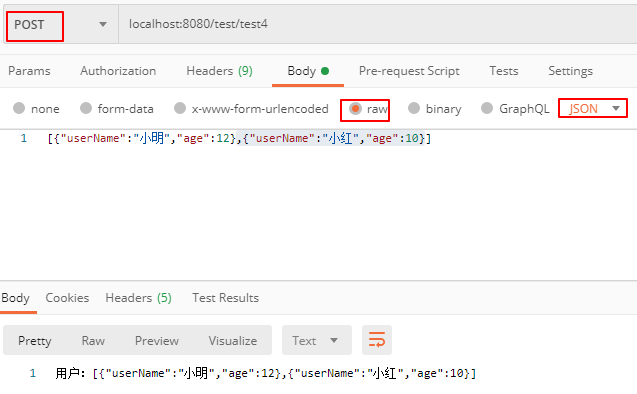基本介绍
-
@requestparam
属性介绍
- required:表示是否必须,默认为
true,必须 - defaultValue:可设置请求参数的默认值
- value:为接收url的参数名(相当于key值)
-
@requestbody
属性介绍
- required:表示是否必须,默认为
true,必须
使用方式
@requestparam
@requestbody
注解@RequestBody接收的参数是来自requestBody中,即请求体。一般用于处理非 Content-Type: application/x-www-form-urlencoded编码格式的数据,比如:application/json、application/xml等类型的数据。就application/json类型的数据而言,使用注解@RequestBody可以将body里面所有的json数据传到后端,后端再进行解析
GET请求中,因为没有HttpEntity,所以@RequestBody并不适用。
POST请求中,通过HttpEntity传递的参数,必须要在请求头中声明数据的类型Content-Type,SpringMVC通过使用HandlerAdapter 配置的HttpMessageConverters来解析HttpEntity中的数据,然后绑定到相应的bean上。
注意:前端使用$.ajax的话,一定要指定 contentType: "application/json;charset=utf-8;",默认为 application/x-www-form-urlencoded。
@PostMapping("test4")
@ResponseBody
public String test4(@RequestBody List<UserEntity> lists) {
return "用户:" + JSONUtil.toJsonStr(lists);
}
@PostMapping("test5")
@ResponseBody
public String test5(@RequestBody List<Map<String, Object>> maps) {
return "用户:" + JSONUtil.toJsonStr(maps);
}
通过postman正确调用:

如果使用form表单提交,就会报错:

get请求:
- 直接获取request 如: public String getHtml(HttpServletRequest request) {}
- 什么也不加,直接在方法中获取参数值 如: public String getHtml(String url, String token) {}
- 利用@RequestParam 如: public User getUserInfo(@RequestParam(value = "url",required = false) String url){}
post请求:
- 直接获取request 如: public String getHtml(HttpServletRequest request) {}
- 使用@RequestBody 可接受的参数 String, Map,JSONObject,或者对应的JavaBean,如: public User getUserInfo(@RequestBody Map<String,String> map){}
- 直接获取request 如: public String getHtml(HttpServletRequest request) {}
区别
用来处理Content-Type为 application/x-www-form-urlencoded编码的内容。(Http协议中,如果不指定Content-Type,则默认传递的参数就是application/x-www-form-urlencoded类型)RequestParam可以接受简单类型的属性,也可以接受对象类型。实质是Request.getParameter() 中的Key-Value参数Map利用Spring的转化机制ConversionService配置,转化成参数接收对象或字段。
在Content-Type为application/x-www-form-urlencoded的请求中,get 方式中queryString的值和post方式中 body data的值都会被Servlet接受到并转化到Request.getParameter()参数集中,所以@RequestParam可以获取的到,除此之外delete类型的请求也可以使用@RequestParam注解。
属性介绍:
- required:表示是否必须,默认为
true,必须 - defaultValue:可设置请求参数的默认值
- value:为接收url的参数名(相当于key值)
@requestbody
处理HttpEntity传递过来的数据,也就是注解@RequestBody接收的参数是来自requestBody中,即请求体。一般用来处理Content-Type不为application/x-www-form-urlencoded编码格式的数据。
1.GET请求中,因为没有HttpEntity,所以@RequestBody并不适用。
2.POST请求中,通过HttpEntity传递的参数,必须要在请求头中声明数据的类型Content-Type,SpringMVC通过使用HandlerAdapter 配置的HttpMessageConverters来解析
required:表示是否必须,默认为 true,必须
- 区别
- 在GET请求中,不能使用@RequestBody。
- 在POST请求,可以使用@RequestBody和@RequestParam,但是如果使用@RequestBody,对于参数转化的配置必须统一。
- 使用@RequestBody接受的参数是不会被Servlet转化统一放在request对象的Param参数集中,@RequestParam是可以的。